13354
Top 10 Programming Languages in 2025
07 Jan, 2025
10 min read
13354
07 Jan, 2025
10 min read
Table of Content
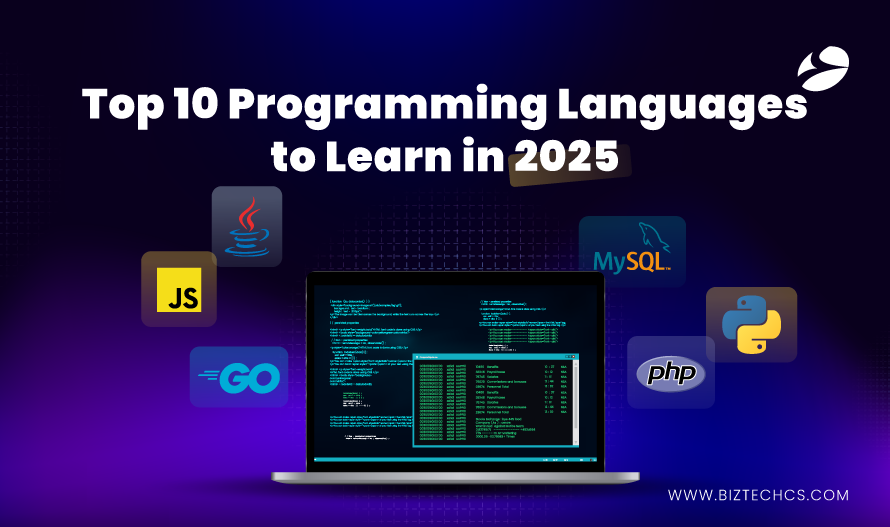
As we look ahead to 2025, the programming landscape is poised for significant transformation. In this blog, we delve into the top 10 programming languages set to shape the future of software development.
With rapid technological advancements, languages like Python, JavaScript, and Rust are leading the charge thanks to their versatility and performance. Meanwhile, newer contenders such as Go and Kotlin are rising quickly, particularly in cloud computing and mobile applications.
Swift and Julia are carving out their space in specialized fields like AI and data science. Additionally, PHP programming services continue to play a crucial role in web development, powering dynamic websites and content management systems. This blog provides insights into these languages and how they influence tomorrow’s industries.
The 2024 rankings from various sources reflect the growing dominance of programming languages like Python across different platforms. TIOBE’s index, which evaluates language popularity based on search engine activity and developer forums, has Python in the lead, followed closely by C++ and Java.
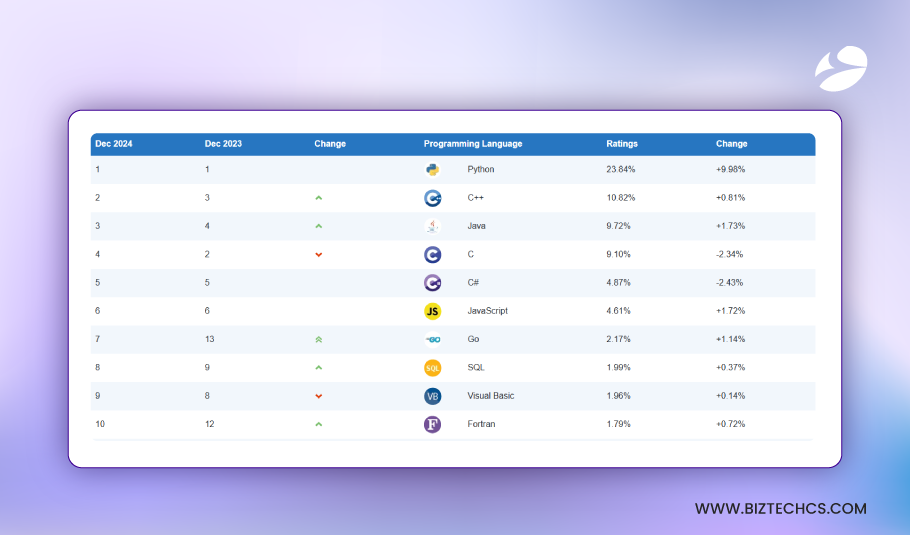
In GitHub’s Octoverse, Python has overtaken JavaScript for the first time in a decade as the most used programming language. TypeScript and Java hold the third and fourth positions, with Python, TypeScript, and Go showing the fastest growth.
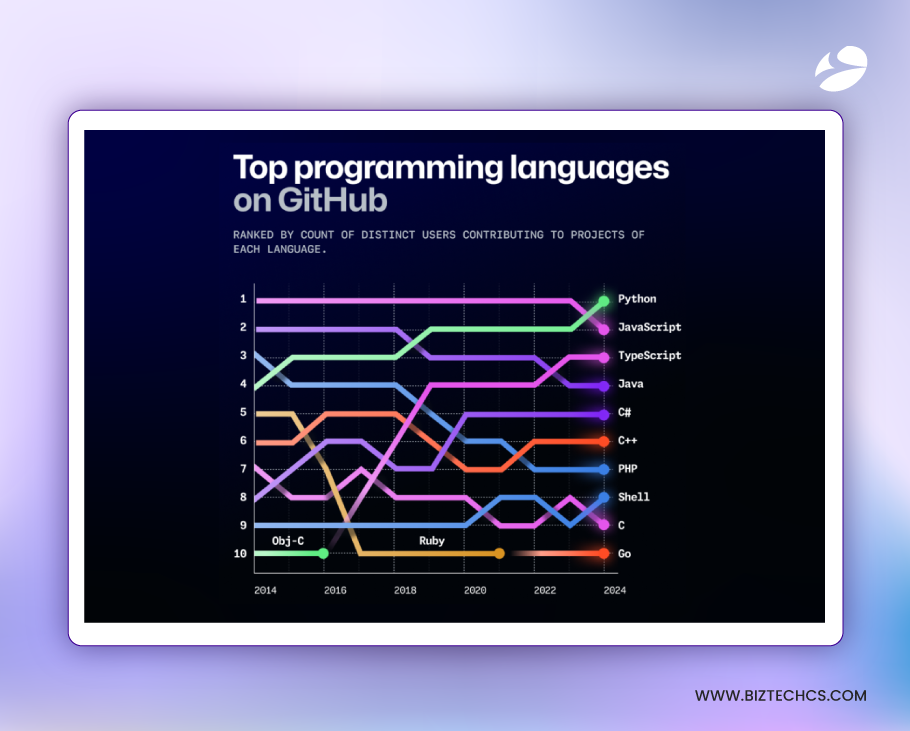
PYPL (Popularity of Programming Languages), which tracks search volume for tutorials, further confirms Python’s top position. Java, JavaScript, and C# also maintain strong rankings.
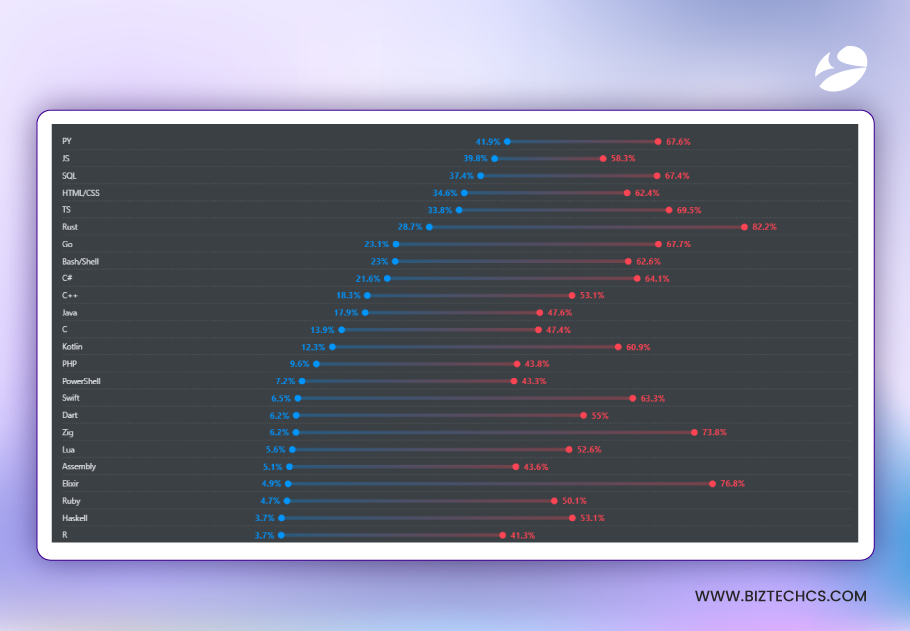
Stack Overflow’s 2024 survey highlights JavaScript, Python, and SQL as the most in-demand languages, with Rust emerging as the most beloved language due to its 82.2% admiration score.
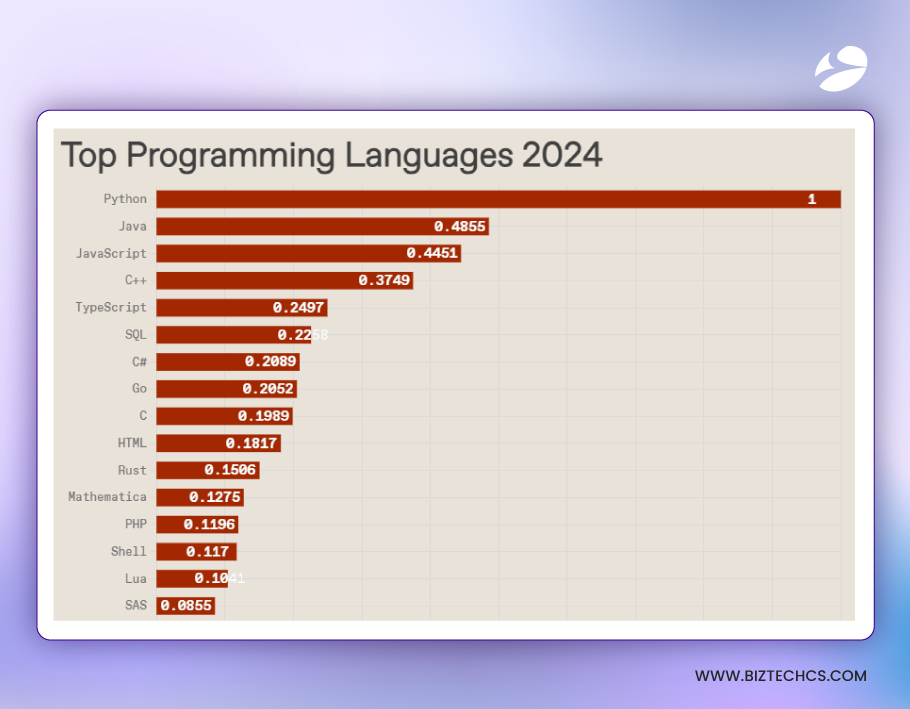
Finally, the IEEE Spectrum ranking, which considers factors like job postings and GitHub activity, shows Python, Java, and JavaScript as the top three languages for 2024.
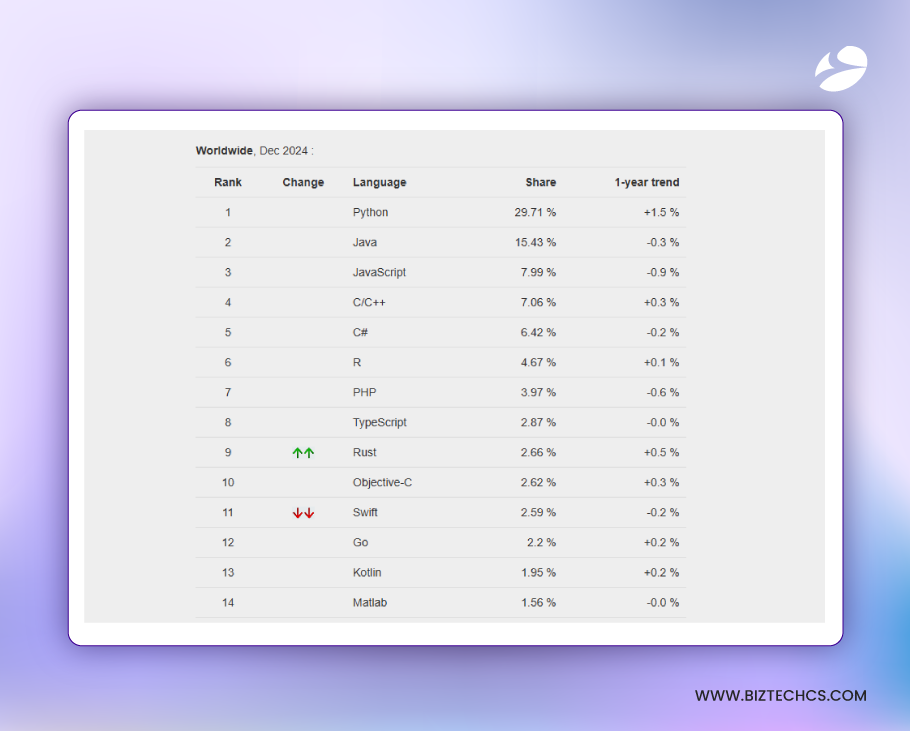
Rust is known for its focus on performance, memory safety, and concurrency. It is gaining traction as a systems programming language, competing with C and C++. Rust offers a strong guarantee against memory leaks and data races, making it ideal for high-performance applications. It is also used extensively in web assembly and embedded systems, ensuring that developers can write safe and efficient code.
Use Cases:
Top Features:
Go, also known as Golang, is a language created by Google that prioritizes simplicity and performance. It excels in building scalable and concurrent systems, such as web servers and networking tools. Its simple syntax makes it easy to learn, while its powerful concurrency features (goroutines and channels) are key for handling many tasks simultaneously. Go is a top choice for cloud services, microservices, and large-scale distributed systems.
Use Cases:
Top Features:
PHP remains one of the most popular languages for server-side PHP web development. Its flexibility and ease of integration with databases make it a go-to choice for building dynamic websites and web applications. Despite facing criticism in some circles, PHP is still widely used due to its large ecosystem and support for popular frameworks like Laravel and Symfony. With the growth of content management systems like WordPress, PHP continues to be relevant in web development.
Use Cases:
Top Features:
SQL (Structured Query Language) is the foundation of relational database management systems. It is essential for querying, updating, and managing data stored in relational databases. SQL remains indispensable in handling structured data, from simple queries to complex data analytics tasks. Its simplicity and efficiency in interacting with databases make it a key language for backend development.
Use Cases:
Top Features:
TypeScript is a statically typed superset of JavaScript that provides optional type checking. It allows developers to catch errors during development, making the code more predictable and maintainable. TypeScript compiles down to JavaScript, making it fully compatible with existing JavaScript libraries. It is becoming the standard for building large-scale web applications and frameworks like Angular and React.
Use Cases:
Top Features:
C# is a versatile and modern programming language primarily used in the Microsoft ecosystem. It is commonly used for developing Windows applications, web applications with ASP.NET, and game development with Unity. C# offers a rich set of libraries and tools, making it easy to build robust software solutions. It also supports object-oriented and functional programming paradigms, offering flexibility to developers.
Use Cases:
Top Features:
C and C++ are powerful languages used for system programming and performance-critical applications. C remains one of the oldest and most efficient languages, ideal for low-level memory manipulation. C++ extends C by adding object-oriented features, making it suitable for larger, more complex software systems. These languages are foundational in fields like gaming, operating systems, and embedded systems.
Use Cases:
Top Features:
Java is one of the most widely used programming languages for building enterprise-level applications. It offers platform independence via the Java Virtual Machine (JVM), allowing developers to write code that runs anywhere. Java is also well-suited for large-scale backend systems and mobile applications (via Android). Its robust ecosystem and strong community support make it a staple in enterprise software development.
Use Cases:
Top Features:
JavaScript remains the most popular language for front-end web development, enabling dynamic and interactive websites. It has become essential for full-stack development, especially with frameworks like Node.js for backend development.
JavaScript Development Services offer tailored solutions for building robust web applications, leveraging the language’s flexibility and scalability. JavaScript is supported by all major web browsers, making it the backbone of web applications.
With its non-blocking I/O, JavaScript is also great for building scalable and responsive applications.
Use Cases:
Top Features:
Python continues to dominate fields like web development, data science, and artificial intelligence due to its simplicity and readability. Python Developers benefit from its vast library ecosystem, which supports rapid application development, whether for machine learning, web apps, or automation.
Python’s syntax is clean and easy to learn, which has contributed to its wide adoption across various industries. It remains a top choice for startups and large enterprises alike.
Use Cases:
Top Features:
Here are a few programming languages that deserve mention for their unique features or contributions to the development world:
Each of these languages brings something unique to the table, whether it’s simplicity, performance, or specialized capabilities.
In conclusion, the programming landscape in 2025 will be shaped by languages like Python, JavaScript, and others that continue to drive innovation. These languages are evolving to meet the demands of emerging technologies and industries. Developers can take inspiration from major tech companies by exploring the Top 8 Programming Languages Used by Amazon, which highlight the tools and technologies driving modern software development.
Developers will need to stay adaptable and continuously learn new tools to remain competitive in the ever-changing tech world. As businesses grow more digital, the demand for skilled developers will only increase.
As a leading provider of web and mobile app development services, Biztech supports businesses with innovative digital solutions.
Our team of dedicated professionals works together to solve challenges and deliver exceptional IT services, driving Biztech to be a global leader in the industry.
In 2025, Python, JavaScript, and Rust stand out due to their versatility, robust ecosystems, and growing adoption in emerging fields like AI, web development, and systems programming. Languages like Go and TypeScript are also gaining traction because of their performance and modern development features tailored to scalable applications.
The best programming languages for 2025 are determined by factors such as technology trends, industry adoption, and developer preferences. Fields like artificial intelligence, cloud computing, and blockchain heavily influence the demand for specific languages.
Job market demand plays a critical role in a language’s popularity, as companies prefer hiring developers skilled in widely-used technologies. For instance, the rise in data science jobs has significantly increased demand for Python, while JavaScript remains vital due to the web’s reliance on it.
Community support ensures access to resources like tutorials, libraries, and problem-solving forums, which is essential for learning and productivity. A strong community also drives innovation and maintenance, keeping the language relevant and updated.
Emerging technologies, developer needs for efficiency, and demand for specialized solutions shape the development of new programming languages. For example, Rust emerged due to the need for safer memory handling and high-performance systems development.
Python is the best language for beginners due to its simple syntax, readability, and extensive documentation. It is widely used in various fields, allowing beginners to explore different domains like data science, web development, and AI.
Scala, Rust, and Go often lead in terms of salary due to their roles in high-demand areas like backend development, cloud infrastructure, and performance-critical applications. These languages are favored in industries requiring high efficiency and scalability, driving their market value.
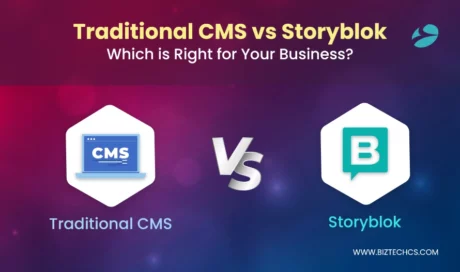
Storyblok
31035
By Devik Gondaliya
02 Apr, 2025

Storyblok
32006
By Devik Gondaliya
01 Apr, 2025
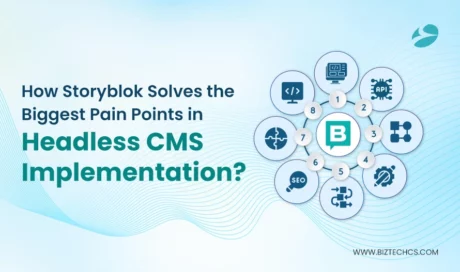
Storyblok
32590
By Devik Gondaliya
27 Mar, 2025